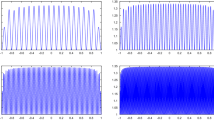Abstract
We consider functions \(\omega \) on the unit circle \({\mathbb T}\) with a finite number of logarithmic singularities. We study the approximation of \(\omega \) by rational functions and find an asymptotic formula for the distance in the \({{\mathrm{BMO}}}\)-norm between \(\omega \) and the set of rational functions of degree n as \(n\rightarrow \infty \). Our approach relies on the Adamyan–Arov–Krein theorem and on the study of the asymptotic behavior of singular values of Hankel operators.
Similar content being viewed by others
References
Adamyan, V.M., Arov, D.Z., Krein, M.G.: Analytic properties of Schmidt pairs for a Hankel operator and the generalized Schur-Takagi problem. Math. USSR-Sb. 15, 31–73 (1971)
Bernstein, S.N.: Sur meilleure approximation de \(|x|\) par des polynômes de degrés donnés. Acta. Math. 37, 1–57 (1914)
Bernstein, S.N.: Sur la meilleure approximation de \(|x|^p\) par des polynômes de degrés très élevés. Izv. Akad. Nauk SSSR Ser. Mat. 2 (1938), 169–180 (Russian), 169–180 (French)
Birman, M.Sh., Solomyak, M.Z.: Spectral Theory of Selfadjoint Operators in Hilbert Space. D. Reidel, Dordrecht (1987)
DeVore, R.A., Lorentz, G.G.: Constructive Approximation. Springer, Berlin (1993)
Erdelyi, A.: General asymptotic expansions of Laplace integrals. Arch. Ration, Mech. Anal. 7(1), 1–20 (1961)
Gohberg, I.C., Krein, M.G.: Introduction to the Theory of Linear Nonselfadjoint Operators. Translations of Mathematical Monographs, 18, Am. Math. Soc. (1969)
Gonchar, A.A.: Estimates of the growth of rational functions and some of their applications. Math. USSR-Sb. 1, 445–456 (1967)
Gonchar, A.A.: On the speed of rational approximation of continuous functions with characteristic singularities. Math. USSR-Sb. 2, 561–568 (1967)
Hartman, P.: On completely continuous Hankel matrices. Proc. Am. Math. Soc. 9, 862–866 (1958)
Koosis, P.: Introduction to \(H_p\) Spaces, 2nd edn. Cambridge University Press, Cambridge (1998)
Lubinsky, D.S.: On the Bernstein constants of polynomial approximation. Constr. Approx. 25(3), 303–366 (2007)
Nehari, Z.: On bounded bilinear forms. Ann. Math. (2) 65, 153–162 (1957)
Newman, D.J.: Rational approximations to \(|x|\). Mich. Math. J. 11, 11–14 (1964)
Nikolski, N.K.: Operators, Functions, and Systems: an Easy Reading, vol. I: Hardy, Hankel, and Toeplitz, Math. Surveys and Monographs vol. 92, Am. Math. Soc., Providence, Rhode Island (2002)
Peller, V.: Hankel Operators and their Applications. Springer, Berlin (2003)
Pekarskiĭ, A.A.: Classes of analytic functions defined by best rational approximation in \(H_{p}\). Math. USSR-Sb. 55, 1–18 (1986)
Pekarskiĭ, A.A.: Chebyshev rational approximation in a disk, on a circle and on a segment. Math. USSR-Sb. 61(1), 87–102 (1988)
Pushnitski, A., Yafaev, D.: Asymptotic behaviour of eigenvalues of Hankel operators. Int. Math. Res. Not. 2015(22), 11861–11886 (2015)
Pushnitski, A., Yafaev, D.: Localization principle for compact Hankel operators. J. Funct. Anal. 270, 3591–3621 (2016)
Saff, E.B., Stahl, H.: Ray sequences of best rational approximants for \(|{x}|^\alpha \). Can. J. Math. 49(5), 1034–1065 (1997)
Semmes, S.: Trace ideal criteria for Hankel operators and application to Besov classes. Int. Equ. Oper. Theory 7, 241–281 (1984)
Stahl, H.R.: Best uniform rational approximation of \(x^\alpha \) on \([0, 1]\). Acta Math. 190, 241–306 (2003)
Triebel, H.: Theory of Function Spaces II. Birkhäuser, Basel (1992)
Wong, R., Lin, J.F.: Asymptotic expansions of Fourier transforms of functions with logarithmic singularities. J. Math. Anal. Appl. 64(1), 173–180 (1978)
Acknowledgments
The authors are grateful to the Departments of Mathematics of King’s College London and of the University of Rennes 1 (France) for the financial support. The second author (D.Y.) acknowledges also the support and hospitality of the Isaac Newton Institute for Mathematical Sciences (Cambridge University, UK), where a part of this work was done during the program Periodic and Ergodic Spectral Problems.
Author information
Authors and Affiliations
Corresponding author
Additional information
Communicated by Pencho Petrushev.
Appendix A. Besov and Besov–Lorentz spaces
Appendix A. Besov and Besov–Lorentz spaces
Here for completeness we recall the definitions of the Besov class \(B_{p,p}^{1/p}\) and the Besov–Lorentz class \(\mathfrak B_{p,\infty }^{1/p}\) on \({\mathbb T}\). The parameter \(p>0\) is arbitrary. We refer to the books [16] (see Section 6.4 and Appendix 2) and [24] for more details.
Let \(w\in C_0^\infty ({\mathbb R})\) be a function with the properties \(w\ge 0\), \({{\mathrm{supp}}}w=[1/2,2]\), and
Let f be a distribution on \(L^1 ({\mathbb T})\) with the Fourier coefficients \(\widehat{f}(j)\), \({j\in {\mathbb Z}}\). For \(n\in {\mathbb Z}\), let us denote by \(f_n\) the polynomial
and let \(f_0(\mu )=\widehat{f}(1)\mu + \widehat{f}(0) + \widehat{f}(-1)\overline{\mu }\). The Besov class \(B_{p,p}^{1/p}\) is defined by the condition
By definition, \(f\in \mathfrak B_{p,\infty }^{1/p}\) if and only if
which is the “weak version” of the condition (A.1). We have
The Hölder–Zygmund class \(\Lambda _\alpha \), \(\alpha >0\), is defined in terms of the difference operator
By definition, \(f\in \Lambda _\alpha \) if and only if
where n is an arbitrary integer such that \(n>\alpha \). Observe that \(\Lambda _\alpha \) coincides with the Hölder class \(C^\alpha \) if \(\alpha \) is not an integer and \(C^\alpha \subset \Lambda _\alpha \) if \(\alpha \) is an integer. We also note that \(\Lambda _{\alpha }\subset \mathfrak {B}^{\alpha }_{1/\alpha ,\infty }\).
Rights and permissions
About this article
Cite this article
Pushnitski, A., Yafaev, D. Best Rational Approximation of Functions with Logarithmic Singularities. Constr Approx 46, 243–269 (2017). https://doi.org/10.1007/s00365-016-9347-1
Received:
Accepted:
Published:
Issue Date:
DOI: https://doi.org/10.1007/s00365-016-9347-1



